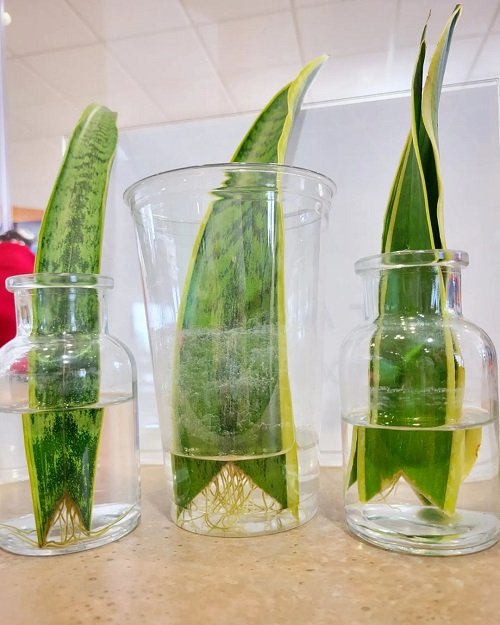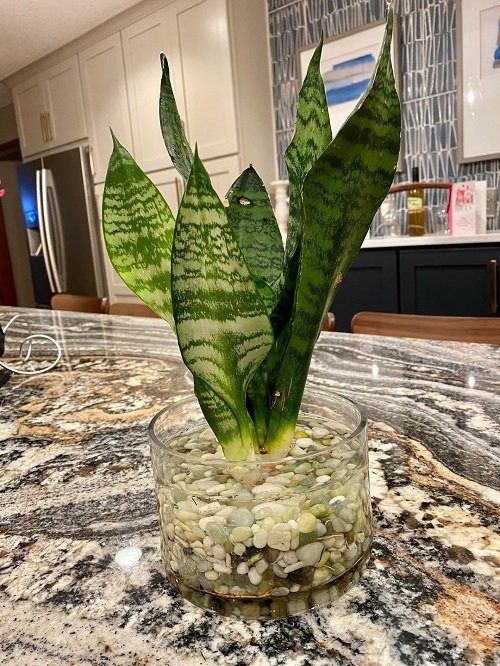
How to grow snake plants in water | Snake plant water propagation guide
Do you want to know how to successfully grow snake plants in water using water propagation? Here is a detailed step-by-step guide to help you grow this air-purifying plant with ease. Get snake plants with this easy and cost-effective method.
The snake plant (Sansevieria) is one plant that you can grow indoors. They are easy to care for and have the characteristic of looking great with all kinds of decorations. If you want to avoid the hassle of pots and soil, then growing snake plants in water can be a simple and interesting option for you. Here we will see in detail all the essential tips and benefits of how to grow snake plants in water.
Can Snake Plants Survive in Water?
Yes, Sansevieria can survive in water! It is a unique plant that can grow in water. You can successfully grow it in water if you take care of the following points:
Propagating snake plants
Things you’ll need:
- Healthy Snake Plant
- clean, sharp knife or scissors
- vase or glass jar
- Water
Snake plant propagation in water is a popular and straightforward method to expand your plant collection. Here’s a step-by-step guide on how to propagate snake plants in water:

1. Select Healthy Snake Plant Cuttings:
- Choose a healthy snake plant with firm leaves and no signs of damage or disease.
- Look for cuttings that have a few inches of stem attached.
2. Prepare the Cuttings:
- Using clean and sharp scissors or pruning shears, make a clean cut just below a leaf node (the point where the leaf attaches to the stem).
- Each cutting should have a leaf attached to a stem section.
3. Cut a V-shaped notch at the bottom of the cutting.
- This increases the surface area for the roots to grow on, and it also helps to know which side is up and which side to water.
4. Place the Cuttings in Water:
- Fill a clean glass jar or vase with distilled or tap water.
- Submerge the bottom inch or two of the cuttings in the water, ensuring the leaves are above the waterline.
- You can place multiple cuttings in the same container, but ensure they are not overcrowded.
5. Provide Indirect Light:
- Place the container with the cuttings in a location with bright, indirect light.
- Avoid direct sunlight, as it can be too intense and may harm the cuttings.
6. Change the Water:
- Regularly check the water to ensure it remains clean and clear.
- Change the water every week or two to prevent stagnation and the growth of algae.
- Rinse the container and cuttings before refilling with fresh water.
7. Monitor Root Development:
- After a few weeks, you should start to see roots developing from the submerged part of the stem.
- Be patient, as it may take several weeks or even a couple of months for significant root growth.
8. Transplant or Maintain in Water:
- Once the roots have developed to a decent length (at least an inch or two), you have two options.
- Transplant to Soil: Carefully remove the cutting from the water and plant it in a pot with well-draining soil.
- Continue Water Propagation: If desired, you can keep the snake plant cuttings in water for a more decorative display.
9. Provide Ongoing Care:
- For water-propagated snake plants, maintain the water level, ensuring the roots are submerged.
- Place the plants in a well-lit area with indirect light and avoid exposing them to harsh environmental conditions.
By following these steps and providing proper care, you can successfully propagate snake plants in water and watch as new roots form, leading to healthy and thriving plants.
Requirements for Growing Snake Plants in Water
Growing snake plants (Sansevieria) in water requires specific conditions to ensure successful growth.
Indirect light: Place the snake plant’s container in an area with bright, indirect light. Snake plants thrive in medium to bright light conditions, but avoid placing them in direct sunlight, as this can cause the leaves to scorch. Morning or evening sunlight is generally tolerable.
Water Quality: Change the water every two weeks to prevent stagnation and the growth of algae. Rinse the container and cuttings before refilling it with fresh water. This helps to maintain a clean and healthy environment for the plants.
Temperature and humidity: snake plants prefer average room temperatures between 65-80°F (18-27°C). Snake plant can tolerate varying levels of humidity but thrives in moderate humidity. Avoid exposing snake plants to extreme temperature fluctuations or drafts
Fertilizer frequency: Apply a diluted fertilizer once every two to three months during the growing season (spring and summer). Reduce or stop fertilizing during the dormant period (fall and winter) when plant growth slows.
Patience and Monitoring: Snake plants can take several weeks to months to develop roots in water. Be patient and monitor the progress of root growth. Keep an eye out for any signs of pests, diseases, or rot and address them promptly.
Where to Keep Water-Grown Snake Plants

Snake plants are versatile and can be placed on desks, dining tables, and tabletops for an elegant look in a variety of indoor locations, such as the living room, bedroom, office, or center table in the hallway.
Conclusion
Sansevierias offers unmatched versatility for indoor spaces, and growing them in water presents an exciting avenue to explore. By bypassing pots and soil, you can effortlessly incorporate these stunning plants into your décor. This guide equips you with all the necessary knowledge to embark on an exciting journey of growing snake plants in water, infusing your space with freshness and ease. Embrace the endless possibilities and enjoy the simplicity of water-based growth while experiencing the beauty of Sansevierias in all their splendor.







Average Rating